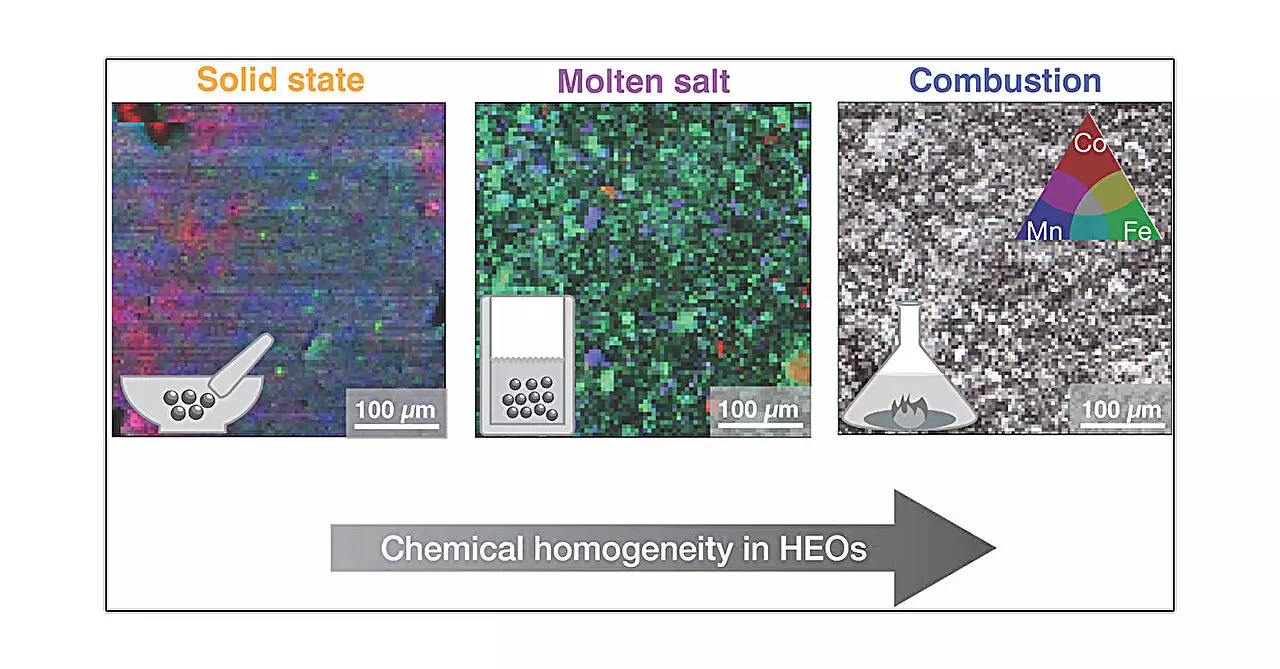Recent advancements in materials science have brought attention to high entropy oxides (HEOs), remarkable materials recognized for their unique structural and functional properties. These materials, composed of five or more elements with comparable proportions, open avenues for a plethora of applications, particularly in electronic devices. A groundbreaking study published in the Journal of the American Chemical Society delves into the intricate ways that various synthesis techniques influence the characteristics of high entropy oxides, marking a significant milestone in this field of research.
Research led by Alannah Hallas from the University of British Columbia’s Blusson Quantum Matter Institute presents compelling evidence that the synthesis methods applied to HEOs can significantly modify their performance, even if the average structure remains unchanged. This paradoxical finding highlights the nuanced relationship between synthesis techniques and material properties, underscoring the necessity for refined approaches in materials engineering.
The researchers employed five distinct synthesis approaches to create HEOs: solid-state synthesis, high-pressure synthesis, hydrothermal synthesis, molten salt synthesis, and combustion synthesis. Each method involves varying conditions of temperature, pressure, and chemical environment, which play pivotal roles in the resultant microstructures and local properties of the materials formed.
For instance, the solid-state synthesis resembles a baking process—mixing raw materials and subjecting them to heat. This method provides a foundational understanding but lacks the dynamic control present in other methods. The high-pressure synthesis introduces additional external pressure during heating, potentially altering crystal formation and enhancing specific characteristics. Hydrothermal synthesis, on the other hand, replicates natural geological processes, utilizing pressurized water to facilitate the growth of crystals. This technique can yield intricate microstructures formed by regulating temperature and pressure, similar to how natural minerals develop within the Earth’s crust.
Molten salt synthesis stands out by employing liquid metal salts to create a thick medium through which crystals can precipitate. This method allows for uniquely tailored particle sizes and shapes, consequently influencing the functional properties of the material. Lastly, combustion synthesis involves an explosive reaction—forming a gel from metal salts that ignites and produces the targeted material in a rapid, self-sustaining fashion.
The findings from this study underscore the importance of synthesis methodologies. While the average architecture of the high entropy oxide remains stable across the process variations, significant deviations in localized structures and microstructures emerge. Notably, combustion synthesis yielded the most uniform samples—a critical aspect when tailoring materials for specific applications.
Lead researcher Mario Ulises González-Rivas argues that understanding the mechanisms behind these synthesis techniques can pave the way for advancements in energy solutions. The structural discrepancies observed directly influence the materials’ performance in real-world applications, especially in energy systems that require precise operational dynamics.
By providing a comprehensive framework for optimizing high entropy oxides, this research opens avenues for innovation, potentially enhancing energy-storage systems and catalysis technologies. As the demand for efficient energy solutions grows, refining the methods of HEO synthesis becomes paramount.
This study is the culmination of a collaborative initiative between Hallas’ team at UBC, Robert Green from the University of Saskatchewan, and Hidenori Takagi from the Max Planck Institute for Solid State Research. It underscores the importance of interdisciplinary cooperation in tackling complex scientific challenges.
As we continue to explore the potential of high entropy oxides, ongoing research and development will be essential in harnessing their capabilities. The implications for technology are vast, from improving the efficacy of electronic devices to advancing renewable energy applications. Thus, this study not only contributes to academic literature but also serves as a catalyst for future innovations in materials science.
The intricate interplay between synthesis methods and material properties presents a frontier of knowledge waiting to be explored. As we deepen our understanding of high entropy oxides, we edge closer to realizing their full potential in energy and technology markets.

